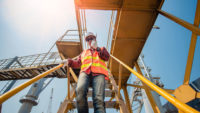PODCAST | The role of technology in enhancing construction safety
KPA's Senior Product Director, Taylor Thorn, discusses the impact of technology on construction safety.

Photo credit: Paul Bradbury / OJO Images / Getty Images Plus
In recent years, the construction industry has seen a significant shift towards the use of technology to improve safety management. This shift has been driven by the need to reduce incidents and increase overall safety on construction sites. One company that is at the forefront of this trend is KPA, a provider of environmental health and safety (EHS) software. In a recent interview with Industrial Safety & Hygiene News, KPA’s Senior Product Director, Taylor Thorn, discussed the state of safety technology in the construction industry and the various ways it is being used to enhance safety.
According to Thorn, one of the key ways that technology has transformed safety management is by providing field-level staff with access to real-time safety data. This data allows foremen, superintendents, and project teams to operate more efficiently and make more informed safety decisions.
“In a nutshell, this access to real-time data is really what has created this safety transparency on the job site, which has become instrumental in these field teams remaining safe,” Thorn explained.
Thorn also highlighted the various stages of a construction project where technology is being used to enhance safety. In the pre-project stage, technology is being used to manage the pre-qualification process for contractors and subcontractors. This includes gathering safety records, proof of insurance, and employee training data. During the on-project stage, safety management software is being used to facilitate day-to-day safety processes, such as inspections, audits, and incident management. Finally, in the post-project stage, technology is being used to analyze safety data and create safety close-out reports.
One of the key benefits of using technology for safety management is the ability to access and analyze large amounts of data. This data can be used to identify trends and areas for improvement, ultimately leading to a reduction in safety incidents.
“At the safety team level, access to more safety data means more meaningful and more informed decisions based on the loads of data that are being collected day in, day out at the job site,” Thorn said.
While the use of technology in construction is not without its challenges, Thorn sees it as a critical component of a comprehensive safety management strategy. Looking ahead, he expects to see continued growth in the use of emerging technologies, such as drones and virtual reality, to enhance safety on construction sites.Looking for a reprint of this article?
From high-res PDFs to custom plaques, order your copy today!








